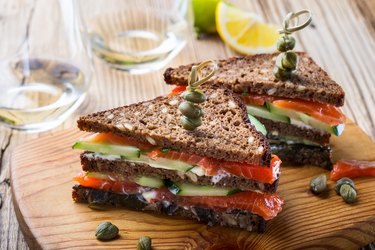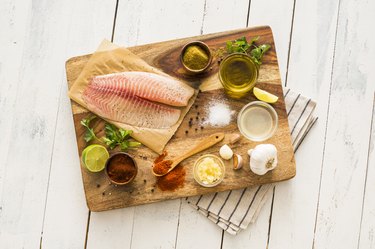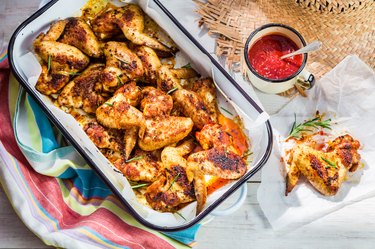Should you cover turkey with foil while it cooks? Well, putting aluminum foil over turkey can help the cooking process as it roasts.
There are two ways to do it: Enclose the turkey in the foil before roasting it in a hot oven or use the foil as a tent to control the level of browning.
Covering the whole turkey with foil is a popular cooking method because it steams the turkey in its own juices, per the University of Illinois Extension. If done correctly, the end result is a wonderfully moist bird with golden brown, non-crispy skin.
When deciding whether to cover your turkey with foil or not, consider that enclosing it makes it cook faster. The compromise here is that the turkey skin, while golden, wont come out crispy.
If youre looking for a crispier result, you should tent your turkey with aluminum foil. The tent method yields perfectly brown, crispy skin and a slow-roasted flavor, but it does takes more time.
It is not recommended to stuff your turkey before cooking it, especially if it is enclosed in a small space, per the USDA. So, if you are fully enclosing your bird in foil, or you are grilling, microwaving or deep-frying, it dont stuff your turkey.
The faster cooking times dont allow the stuffing to heat quickly enough to kill food-borne bacteria in the stuffing. If you are tenting the turkey, you can stuff it, per the University of Illinois Extension.
Cooking the perfect turkey for Thanksgiving or any special occasion can be a daunting task. Many home cooks wonder if covering the bird with aluminum foil while it roasts will help ensure a moist, juicy turkey with crispy skin. Here’s a detailed look at the pros and cons of using foil when roasting turkey and expert tips for the best results.
Why Use Foil?
Covering the turkey with aluminum foil while it cooks offers some potential benefits
-
Prevents drying out: Foil traps moisture and steam around the turkey as it cooks, helping to keep the meat juicy and tender. This is especially useful for the breast meat, which tends to dry out faster than the legs and thighs.
-
Promotes even cooking: The foil helps the turkey roast evenly, especially if you cover just the breast. It prevents the breast from overcooking while the legs finish cooking.
-
Easy to use: Aluminum foil is readily available, inexpensive, and easy to form into a tent over the turkey. This makes it a convenient option for most home cooks.
-
Can add flavor You can put aromatics like garlic herbs citrus, or onions under the foil to infuse the turkey with extra flavor. The steam helps transfer those flavors to the meat.
Why Not Use Foil?
However, there are a few reasons why you may want to roast your turkey without foil:
-
No crispy skin: Foil placed over the turkey can make the skin soggy and prevent it from crisping up nicely. Uncovering the turkey for the last 30-60 minutes may help, but results can be mixed.
-
Traps moisture: While retaining moisture sounds great, too much moisture trapped around the turkey results in soggy, almost steamed meat. The texture suffers without more exposure to dry oven heat.
-
Messy application: Getting foil to loosely tent over a whole turkey can be challenging. If it touches the skin, it prevents crisping. And if it’s sealed too tightly, you lose the moisture benefits.
-
Can impact flavor: Some feel foil creates a metallic taste or steam that dilutes the turkey’s natural flavors. Cooking without foil allows for better caramelization and flavor development on the skin.
Expert Tips for Using Foil
If you do want to use foil when cooking your turkey, here are some tips:
-
Only cover the breast and top of drumsticks, leaving the legs exposed. This prevents overcooking white meat while allowing crisping on the legs.
-
Use a foil “tent” with plenty of headroom, not wrapped tightly. This allows for circulation and some moisture release.
-
Add broth, wine, or water to the bottom of the pan before covering with foil. The liquid helps create steam for added moisture.
-
Remove foil 30-60 minutes before the turkey is fully cooked. This gives the skin time to crisp up at the end. Watch closely to prevent burning.
-
Combine foil with a lower oven temp (325°F) for a very moist bird. The foil protects it from drying out at the longer cook time. Higher heat is better for crisp skin.
-
Place a layer of cheesecloth or parchment paper between the foil and turkey skin. This prevents the foil from sticking while still trapping moisture.
-
Start breast or legs-side down, then flip and add foil halfway through. This exposes all sides to direct heat for browning before covering to finish cooking.
Should You Use Foil or Not?
Whether to use foil or not comes down to your priorities – do you want the absolute juiciest turkey possible, or do you prefer deep golden crispy skin with pronounced flavors? There’s no right or wrong answer, only personal preference.
If moistness is most important, use foil loosely tented over the breast and drumsticks for most of the roasting time. For crispy skin lovers, cook uncovered from start to finish, basting periodically. Or compromise with uncovered legs and partial foil coverage on the breast. Pay close attention near the end to prevent burning or overcooking.
With some trial and error, you can find the method that works for your oven, turkey size, and cooking preferences. Don’t be afraid to experiment and adjust your technique each year for the perfect Thanksgiving bird! Proper resting, brining, temperature monitoring, and basting all play a role too. But foil can be a useful tool in the roasting process when used judiciously.

Foil Tent Turkey Cooking Instructions
- Preheat the oven to 325 degrees Fahrenheit.
- Place the turkey in the roasting pan breast-side up.
- Brush the turkey with melted butter or olive oil.
- How to tent with foil? Make a tent-shape with the foil by creasing a piece of foil in the center. Prop it up over the turkey. The ends will be in the roasting pan. Stand the center up 1 inch over the turkey breast to allow for air flow.
- Put the turkey in the oven. Roast it until a thermometer inserted in the innermost part of the thigh and wing and the thickest part of the breast reaches 165 degrees Fahrenheit, per the University of Illinois Extension. Let the turkey stand for 20 minutes, as recommended by the USDA Food Safety and Inspection Service, to improve ease of carving.
How to Cook a Turkey With Aluminum Foil
To cover or not to cover a turkey? If you have a limited amount of time to roast your bird, you can cover turkey in aluminum foil beforehand, which will shorten the cooking time. Just make sure you dont seal the foil so its airtight, or moisture will be trapped inside and affect the end result.



- Preheat the oven to 450 degrees Fahrenheit, according to the University of Illinois Extension.
- Tear off a piece of 18-inch-wide, heavy-duty aluminum foil that is three times longer than the length of the turkey. Lay it over a large roasting pan, centered lengthwise.
- Place the turkey on the aluminum foil breast-side up. Brush the turkey with melted butter or vegetable oil.
- Bring the sides of the aluminum foil up along the sides of the turkey. Bring the ends of the foil up over the top of the turkey. Overlap the ends of the foil so they will stay in place, but dont seal them so they are airtight.
- Put the turkey in the oven. Roast the turkey until a meat thermometer inserted into the thickest part of the thigh reads a minimum of 165 Fahrenheit, according to the University of Illinois Extension.
The cooking time for a turkey wrapped in foil will vary based on the weight of your bird. An 8- to 12-pound turkey will need 2.75 to 3 hours to cook through at 325 F, according to the USDA Food Safety and Inspection Service. Roasting at a higher temperature lowers this cooking time.
At What Temperature Should You Cook Your Turkey?
Your oven temperature should be set at no lower than 325 F, according to the USDA. A higher temperature will speed up the cooking time.
When it comes to foil-wrapped turkey, you can set your oven at a higher temperature — the University of Illinois Extension suggests 450 F.
A whole turkey is safe to eat when its internal temperature is a minimum of 165 F, which can be measured with a food thermometer.
Should I cover the turkey with foil while it cooks in the oven?
Should you cover a Turkey with aluminum foil?
Yes, covering your turkey with aluminum foil is recommended when roasting a whole turkey. This method helps to prevent the turkey from drying out, while still allowing the skin to crisp. It is the best way to cook a turkey and ensures a moist and golden result. To enhance the browning, remove the foil cover for the last 30 minutes of cooking. 1.
What happens if you don’t cover a Turkey with foil?
If you do not cover a turkey with foil, the turkey may dry out. The skin will not brown evenly, and the turkey may not cook evenly. Additionally, the turkey may take longer to cook. To avoid this problem, it is important to cover the turkey with foil during the first half of cooking time.
When should you cover a Turkey with foil?
When to cover a turkey with foil The best time to cover a turkey with foil depends on the type of turkey you are roasting and the temperature at which you are roasting it. * When roasting a turkey at a low temperature (325 degrees F or below), you should cover the turkey with foil for the first half of the cooking time.
Should you wrap a Turkey in foil before cooking?
While it may seem like a good idea to wrap your turkey in foil before cooking it, it is recommended to only cover it loosely with foil. The foil helps to keep the turkey moist and prevent excessive browning, but it should be removed about an hour before the cooking time is up to allow the turkey to brown nicely.
